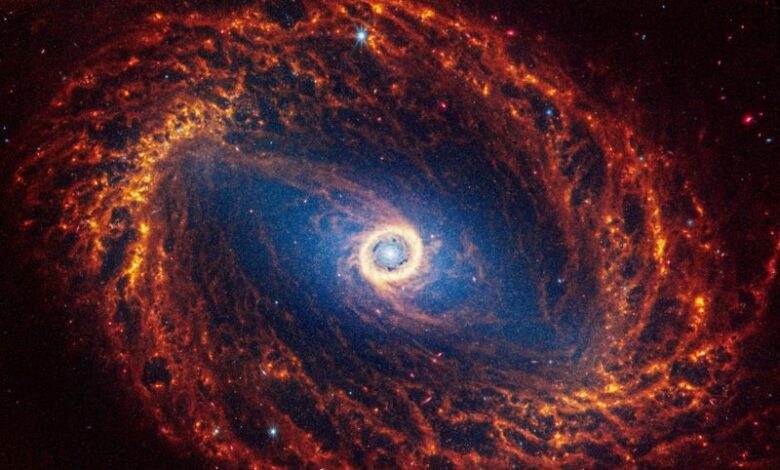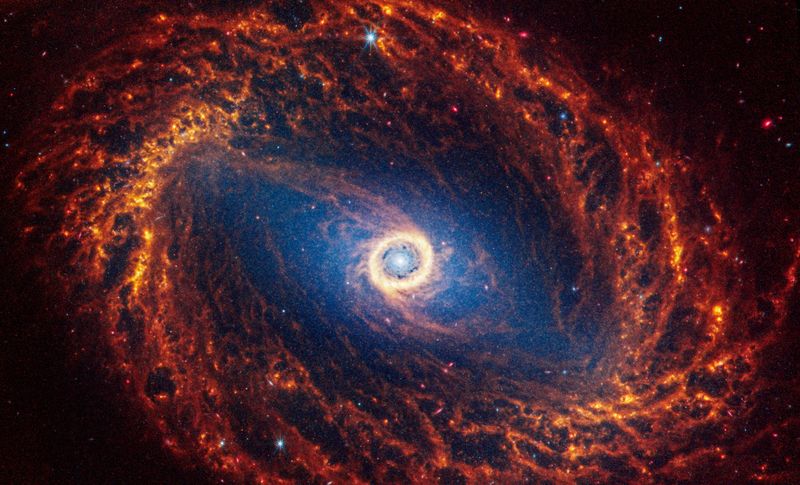Webb telescope captures ‘gorgeous’ photos of 19 spiral galaxies By Reuters

[ad_1]

© Reuters. Spiral galaxy NGC 1512, situated 30 million light-years away from Earth, is seen in an undated picture from the James Webb Area Telescope. NASA, ESA, CSA, STScI, Janice Lee (STScI), Thomas Williams (Oxford), and the PHANGS staff/Handout through REUTERS
2/5
By Will Dunham
WASHINGTON (Reuters) – A batch of newly launched photos captured by the James Webb Area Telescope present in exceptional element 19 spiral galaxies residing comparatively close to our Milky Approach, providing new clues on star formation in addition to galactic construction and evolution.
The pictures had been made public on Monday by a staff of scientists concerned in a undertaking known as Physics at Excessive Angular decision in Close by GalaxieS (PHANGS) that operates throughout a number of main astronomical observatories.
The closest of the 19 galaxies known as NGC5068, about 15 million gentle years from Earth, and probably the most distant of them is NGC1365, about 60 million gentle years from Earth. A light-weight 12 months is the gap gentle travels in a 12 months, 5.9 trillion miles (9.5 trillion km).
The James Webb Area Telescope (JWST) was launched in 2021 and started accumulating information in 2022, reshaping the understanding of the early universe whereas taking wondrous photos of the cosmos. The orbiting observatory appears to be like on the universe primarily within the infrared. The Hubble Area Telescope, launched in 1990 and nonetheless operational, has examined it primarily at optical and ultraviolet wavelengths.
Spiral galaxies, resembling huge pinwheels, are a standard galaxy kind. Our Milky Approach is one.
The brand new observations got here from Webb’s Close to-Infrared Digital camera (NIRCam) and Mid-Infrared Instrument (MIRI). They present roughly 100,000 star clusters and tens of millions or maybe billions of particular person stars.
“These information are necessary as they offer us a brand new view on the earliest section of star formation,” stated College of Oxford astronomer Thomas Williams, who led the staff’s information processing on the photographs.
“Stars are born deep inside dusty clouds that fully block out the sunshine at seen wavelengths – what the Hubble Area Telescope is delicate to – however these clouds gentle up on the JWST wavelengths. We do not know loads about this section, not even actually how lengthy it lasts, and so these information will probably be important for understanding how stars in galaxies begin their lives,” Williams added.
About half of spiral galaxies have a straight construction, known as a bar, popping out from the galactic heart to which the spiral arms are hooked up.
“The generally held thought is that galaxies kind from the inside-out, and so get greater and larger over their lifetimes. The spiral arms act to comb up the gasoline that can kind into stars, and the bars act to funnel that very same gasoline in in direction of the central black gap of the galaxy,” Williams stated.
The pictures let scientists for the primary time resolve the construction of the clouds of mud and gasoline from which stars and planets kind at a excessive degree of element in galaxies past the Massive Magellanic Cloud and Small Magellanic Cloud, two galaxies thought of galactic satellites of the sprawling Milky Approach.
“The pictures are usually not solely aesthetically gorgeous, in addition they inform a narrative concerning the cycle of star formation and suggestions, which is the vitality and momentum launched by younger stars into the house between stars,” stated astronomer Janice Lee of the Area Telescope Science Institute in Baltimore, principal investigator for the brand new information.
“It really appears to be like like there was explosive exercise and clearing of the mud and gasoline on each cluster and kiloparsec (roughly 3,000 gentle years) scales. The dynamic means of the general star formation cycle turns into apparent and qualitatively accessible, even for the general public, which makes the photographs compelling on many alternative ranges,” Lee added.
Webb’s observations construct on Hubble’s.
“Utilizing Hubble, we might see the starlight from galaxies, however among the gentle was blocked by the mud of galaxies,” College of Alberta astronomer Erik Rosolowsky stated. “This limitation made it laborious to grasp components of how a galaxy operates as a system. With Webb’s view within the infrared, we are able to see by means of this mud to see stars behind and throughout the enshrouding mud.”
[ad_2]
Source link




